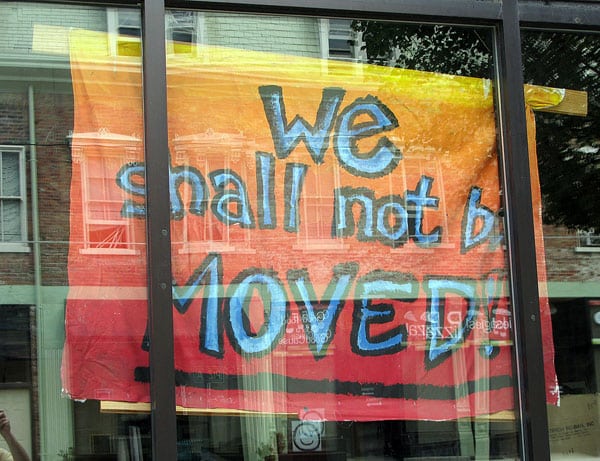
July 10, 2018; TruthOut
“On Saturday, July 7, social media was flooded with images of an event in Chicago that was advertised as a shutdown of the Dan Ryan Expressway to protest gun violence,” write organizers Kelly Hayes, Mariame Kaba, and Monica Trinidad in TruthOut. “Led by celebrity-pastor Father Michael Pfleger and cosponsored by half a dozen local groups, 3,000 people marched onto the expressway, at first only occupying two lanes, with the permission of state police. After about an hour, Pfleger announced that state police would be shutting down all four lanes of traffic.”
“Some,” note Hayes and her colleagues, “celebrated the protest as a powerful act of resistance. In Chicago and elsewhere, some of us who do the work of direct action and community organizing were far less impressed.” Indeed, the reality was far messier, with major political figures, including the mayor and school superintendent, supporting the action.
The point, Hayes and her coauthors explain, is not that civil disobedience is always the preferred tactic. “We are striving for clarity rather than condemnation. Having a permitted march is not inherently bad, but, like petitions or calls to our elected officials, these are less about disrupting power than they are about appealing to it.”
When might a social movement decide that civil disobedience is appropriate? “Direct action,” Hayes and colleagues note, “is often an escalation and a tactical response to a system that is not offering acceptable outcomes.” Or, as Berkeley free speech movement activist Mario Savio once more dramatically put it:
There’s a time when the operation of the machine becomes so odious, makes you so sick at heart, that you can’t take part! You can’t even passively take part! And you’ve got to put your bodies upon the gears and upon the wheels…upon the levers, upon all the apparatus, and you’ve got to make it stop! And you’ve got to indicate to the people who run it, to the people who own it, that unless you’re free, the machine will be prevented from working at all.
Sign up for our free newsletters
Subscribe to NPQ's newsletters to have our top stories delivered directly to your inbox.
By signing up, you agree to our privacy policy and terms of use, and to receive messages from NPQ and our partners.
So, if you are trying to stop the machine, how should you do so? Building on the work of Dean Spade, Peter Gelderloos, and others, Hayes, Kaba, and Trinidad provide a valuable concise guide of key questions to ask yourself, which are paraphrased below. These include:
- Does your action legitimize harmful institutions?
- Does it legitimize or expand a system you are trying to dismantle? (For example, what does it mean to cooperate with cops as part of organizing your action? If the goal is to shrink the power of policing, why are you thanking them for their presence rather than calling for their removal?”)
- Does it have elite support?
- Is the action colluding with power or resisting it?
- Is there a clear demand that will improve the lives of the most marginalized?
To summarize: If you are colluding with authority and lack a clear demand, then you’re doing something other than direct action. It also, the authors emphasize, matters who benefits from the action and who is organizing it.
What does a direct action look like? Writer and activist adrienne maree brown describes one that took place in Oakland, California, following the refusal of a Ferguson grand jury to indict police officer Darren Wilson for killing Michael Brown:
The action…was perfection. Every entrance into the Oakland police department was blockaded. The street in front of the entrance was blockaded on both ends, abundantly. The banners were stunning and clear—“black and breathing,” “complacency is consent,” and a flag flying from the OPD [Oakland Police Department] flagpole, held in place by a brave human who scaled it with muscle and rope, with the faces of our recent martyrs, stating once again that “Black Lives Matter.”
Brown notes that what made the action powerful was “the messaging, leadership and visibility of young black leaders, stepping and chanting and singing and marching and fists in the air claiming historical space [while], just as clearly, allies were providing cover, taking risks, embodying solidarity.”
As Hayes, Kaba, and Trinidad remind us, “Ultimately, no system of injustice will consent to its own overthrow and the system will never indict itself. People who have won great victories in liberation struggles have not done so by getting the step-by-step consent of their oppressors. They took strategic risks, and often suffered for them. There is nothing in our current historical context that exempts us from the realities of power or history—and anyone who suggests otherwise is not working in furtherance of our liberation.”—Steve Dubb













